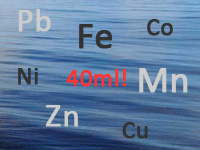Measuring precisely with only 40 ml of sample
 It is now possible to measure precisely manganese (Mn), iron (Fe), cobalt (Co), nickel (Ni), copper (Cu), zinc (Zn), cadmium (Cd), and lead (Pb) concentrations in seawater using only 40 ml of sample.
It is now possible to measure precisely manganese (Mn), iron (Fe), cobalt (Co), nickel (Ni), copper (Cu), zinc (Zn), cadmium (Cd), and lead (Pb) concentrations in seawater using only 40 ml of sample.
All the cooking recipes and techniques are given in the recent detailed article of Dondra Biller and Kenneth Bruland in Marine Chemistry (Biller and Bruland, 2012). A work full of perspectives for trace metal measurements in the framework of GEOTRACES. Don’t miss it!
Reference:
Biller Dondra V., Bruland Kenneth W. (2012) Analysis of Mn, Fe, Co, Ni, Cu, Zn, Cd, and Pb in seawater using the Nobias-chelate PA1 resin and magnetic sector inductively coupled plasma mass spectrometry (ICP-MS) Marine Chemistry 130-131 (2012) 12–20 DOI: 10.1016/j.marchem.2011.12.001
